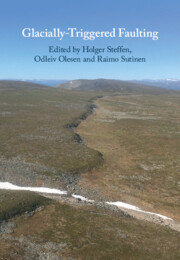Book contents
- Glacially-Triggered Faulting
- Glacially-Triggered Faulting
- Copyright page
- Contents
- Figures
- Tables
- Contributors
- Preface
- Part I Introduction
- Part II Methods and Techniques for Fault Identification and Dating
- Part III Glacially Triggered Faulting in the Fennoscandian Shield
- Part IV Glacially Triggered Faulting at the Edge and in the Periphery of the Fennoscandian Shield
- 15 Lateglacial and Postglacial Faulting in Denmark
- 16 Glacially Induced Faults in Germany
- 17 Glacially Induced Faulting in Poland
- 18 Soft-Sediment Deformation Structures in the Eastern Baltic Region
- Part V Glacially Triggered Faulting Outside Europe
- Part VI Modelling of Glacially Induced Faults and Stress
- Part VII Outlook
- Index
- References
18 - Soft-Sediment Deformation Structures in the Eastern Baltic Region
Implication in Seismicity and Glacially Triggered Faulting
from Part IV - Glacially Triggered Faulting at the Edge and in the Periphery of the Fennoscandian Shield
Published online by Cambridge University Press: 02 December 2021
- Glacially-Triggered Faulting
- Glacially-Triggered Faulting
- Copyright page
- Contents
- Figures
- Tables
- Contributors
- Preface
- Part I Introduction
- Part II Methods and Techniques for Fault Identification and Dating
- Part III Glacially Triggered Faulting in the Fennoscandian Shield
- Part IV Glacially Triggered Faulting at the Edge and in the Periphery of the Fennoscandian Shield
- 15 Lateglacial and Postglacial Faulting in Denmark
- 16 Glacially Induced Faults in Germany
- 17 Glacially Induced Faulting in Poland
- 18 Soft-Sediment Deformation Structures in the Eastern Baltic Region
- Part V Glacially Triggered Faulting Outside Europe
- Part VI Modelling of Glacially Induced Faults and Stress
- Part VII Outlook
- Index
- References
Summary
This section presents a detailed overview of soft-sediment deformation structures of possibly seismic origin in the Eastern Baltic Region. Recent studies of soft-sediment deformation structures discovered in Estonia, Latvia, Lithuania, Belarus and the Kaliningrad District of Russia demonstrated that their formation could have been caused by fluidization and liquefaction of sediments possibly triggered by palaeoearthquakes; thus, they could be interpreted as seismites. An identification of corresponding seismogenic faults is complicated though due to the rather small scale of the tectonic dislocations in the intracratonic area with up to 2.5-km thick Phanerozoic sedimentary cover. Nevertheless, a part of soft-sediment deformation structures can be interpreted as seismites and attributed to the seismic events triggered by glacial isostatic adjustment of the lithosphere during the Last (Weichselian) glacial advance and subsequent deglaciation.
Keywords
- Type
- Chapter
- Information
- Glacially-Triggered Faulting , pp. 320 - 338Publisher: Cambridge University PressPrint publication year: 2021
References
- 2
- Cited by

